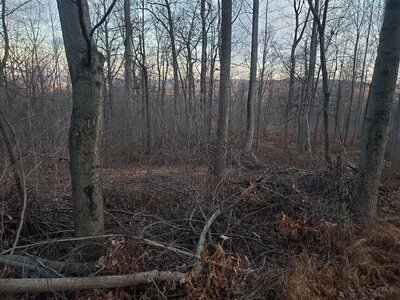Mennoniteman
Well-Known Member
The great thing about a spreadsheet is that it does a lot of math in a hurry, and can show a picture of numbers that are easier to grasp than just doing the same numbers one at a time on a calculator. Recently I've been playing with deer management statistics on a spreadsheet, and, as I loaded the numbers, one glaring deer management fact that I often overlook quickly became evident. This is a statistic that I knew before, but hadn't ever really considered the full importance of it in figuring out how many deer a piece of land can carry, and what the buck/ doe ratio on any given piece of land should be.
Regarding buck antler size, us hunters always tend to simplify the matter and say "that one needs another year", or, "just let them grow bigger" as we often tend to think we can shoot the same bucks as big bucks instead of shooting them as smaller bucks the year before. However, as this chart points out, it's not quite that simple, actually it takes a lot more land to grow big bucks.
So, here it is, the fact that all else being equal, in looking at a piece of land as a limited resource that can only carry so many deer per acre, according to my management chart, it clearly shows that it takes twice the amount of land to grow bucks to 2 year old maturity before harvest as it does to grow the same amount of bucks to 1 year old maturity, three times the land to grow bucks to 3 year old maturity, and four times the land to grow bucks to 4 year old maturity.
The driving factor for this equation is that, in order to have enough food to feed the bigger buck herd needed to enable harvesting only 4 year old bucks, the doe herd is going to have to be reduced by equal numbers to provide this required food, resulting in less replacement buck fawns each year. Not reducing the doe herd to provide this required buck food is the worst management mistake that can be made, resulting in poor quality deer and antlers all around.
For someone making their own deer management plan, if a deer herd is balanced at the starting point, all that's needed to maintain balanced herd numbers is to harvest the correct number of bucks, and harvest one doe for every buck harvested, which will maintain a balanced buck/doe ratio.
But the most important thing that this chart shows is that "the core of deer management is a very careful management of doe herd numbers".

Regarding buck antler size, us hunters always tend to simplify the matter and say "that one needs another year", or, "just let them grow bigger" as we often tend to think we can shoot the same bucks as big bucks instead of shooting them as smaller bucks the year before. However, as this chart points out, it's not quite that simple, actually it takes a lot more land to grow big bucks.
So, here it is, the fact that all else being equal, in looking at a piece of land as a limited resource that can only carry so many deer per acre, according to my management chart, it clearly shows that it takes twice the amount of land to grow bucks to 2 year old maturity before harvest as it does to grow the same amount of bucks to 1 year old maturity, three times the land to grow bucks to 3 year old maturity, and four times the land to grow bucks to 4 year old maturity.
The driving factor for this equation is that, in order to have enough food to feed the bigger buck herd needed to enable harvesting only 4 year old bucks, the doe herd is going to have to be reduced by equal numbers to provide this required food, resulting in less replacement buck fawns each year. Not reducing the doe herd to provide this required buck food is the worst management mistake that can be made, resulting in poor quality deer and antlers all around.
For someone making their own deer management plan, if a deer herd is balanced at the starting point, all that's needed to maintain balanced herd numbers is to harvest the correct number of bucks, and harvest one doe for every buck harvested, which will maintain a balanced buck/doe ratio.
But the most important thing that this chart shows is that "the core of deer management is a very careful management of doe herd numbers".



